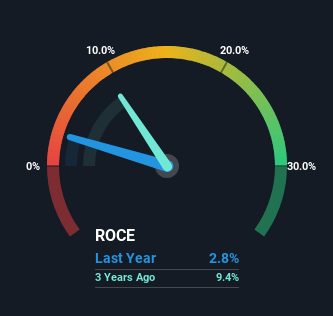What are the early trends we should look for to identify a stock that could multiply in value over the long term? Amongst other things, we'll want to see two things; firstly, a growing return on capital employed (ROCE) and secondly, an expansion in the company's amount of capital employed. This shows us that it's a compounding machine, able to continually reinvest its earnings back into the business and generate higher returns. So on that note, Bunkyodo Group Holdings (TSE:9978) looks quite promising in regards to its trends of return on capital.
Return On Capital Employed (ROCE): What Is It?
Just to clarify if you're unsure, ROCE is a metric for evaluating how much pre-tax income (in percentage terms) a company earns on the capital invested in its business. Analysts use this formula to calculate it for Bunkyodo Group Holdings:
Return on Capital Employed = Earnings Before Interest and Tax (EBIT) ÷ (Total Assets - Current Liabilities)
0.028 = JP¥91m ÷ (JP¥9.6b - JP¥6.3b) (Based on the trailing twelve months to May 2024).
Therefore, Bunkyodo Group Holdings has an ROCE of 2.8%. Ultimately, that's a low return and it under-performs the Specialty Retail industry average of 10%.
View our latest analysis for Bunkyodo Group Holdings

While the past is not representative of the future, it can be helpful to know how a company has performed historically, which is why we have this chart above. If you want to delve into the historical earnings , check out these free graphs detailing revenue and cash flow performance of Bunkyodo Group Holdings.
What The Trend Of ROCE Can Tell Us
It's great to see that Bunkyodo Group Holdings has started to generate some pre-tax earnings from prior investments. The company was generating losses five years ago, but now it's turned around, earning 2.8% which is no doubt a relief for some early shareholders. Additionally, the business is utilizing 25% less capital than it was five years ago, and taken at face value, that can mean the company needs less funds at work to get a return. The reduction could indicate that the company is selling some assets, and considering returns are up, they appear to be selling the right ones.
One more thing to note, Bunkyodo Group Holdings has decreased current liabilities to 66% of total assets over this period, which effectively reduces the amount of funding from suppliers or short-term creditors. So shareholders would be pleased that the growth in returns has mostly come from underlying business performance. However, current liabilities are still at a pretty high level, so just be aware that this can bring with it some risks.
Our Take On Bunkyodo Group Holdings' ROCE
In a nutshell, we're pleased to see that Bunkyodo Group Holdings has been able to generate higher returns from less capital. Although the company may be facing some issues elsewhere since the stock has plunged 71% in the last five years. In any case, we believe the economic trends of this company are positive and looking into the stock further could prove rewarding.
Bunkyodo Group Holdings does come with some risks though, we found 3 warning signs in our investment analysis, and 2 of those can't be ignored...
While Bunkyodo Group Holdings isn't earning the highest return, check out this free list of companies that are earning high returns on equity with solid balance sheets.
Valuation is complex, but we're here to simplify it.
Discover if Bunkyodo Group Holdings might be undervalued or overvalued with our detailed analysis, featuring fair value estimates, potential risks, dividends, insider trades, and its financial condition.
Access Free AnalysisHave feedback on this article? Concerned about the content? Get in touch with us directly. Alternatively, email editorial-team (at) simplywallst.com.
This article by Simply Wall St is general in nature. We provide commentary based on historical data and analyst forecasts only using an unbiased methodology and our articles are not intended to be financial advice. It does not constitute a recommendation to buy or sell any stock, and does not take account of your objectives, or your financial situation. We aim to bring you long-term focused analysis driven by fundamental data. Note that our analysis may not factor in the latest price-sensitive company announcements or qualitative material. Simply Wall St has no position in any stocks mentioned.
Have feedback on this article? Concerned about the content? Get in touch with us directly. Alternatively, email editorial-team@simplywallst.com
About TSE:9978
Bunkyodo Group Holdings
Operates various wholesale and retail stores in Japan.
Low risk and slightly overvalued.
Market Insights
Community Narratives



